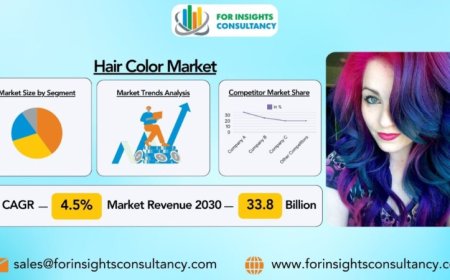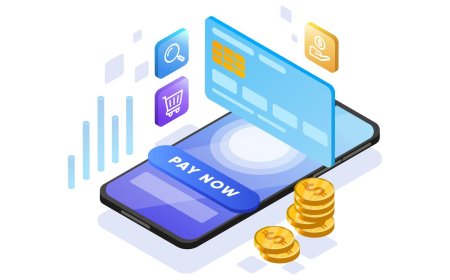Top 6 Trends Shaping the Future of Mobile App Development
Explore 6 top trends shaping mobile app development: AI, XR, 5G/Edge, low-code, enhanced security, and IoT integration. Stay ahead in the mobile landscape.
The mobile app landscape is a perpetual motion machine, constantly evolving in response to technological advancements, shifting user behaviors, and innovative market demands. For a Mobile App Development Company, staying ahead of these trends isn't just about competitive advantage; it's about survival and relevance. As we look into the near future, several powerful currents are converging to redefine what mobile applications are capable of, how they are built, and how they interact with our lives.
Here are the top 6 trends poised to shape the future of mobile app development:
1. Artificial Intelligence (AI) and Machine Learning (ML) Integration
AI and ML are no longer nascent technologies; they are becoming foundational elements of mobile app functionality. From enhancing user experience to automating backend processes, their pervasive integration is set to revolutionize every facet of mobile applications.
-
Personalization and Predictive Analytics: AI algorithms analyze vast amounts of user data behavior, preferences, location, and past interactions to deliver highly personalized experiences. This includes tailored content recommendations (e.g., streaming services, e-commerce), dynamic UI adjustments, and intelligent notifications. Predictive analytics anticipate user needs, enabling apps to offer proactive assistance or suggest relevant actions before explicit commands.
-
Voice and Natural Language Processing (NLP): The rise of voice assistants and hands-free interactions continues to drive the adoption of NLP in apps. Users expect to interact with apps using natural language, whether for search queries, command execution, or seamless customer support via AI-powered chatbots. This enhances accessibility and user convenience.
-
Enhanced Security and Fraud Detection: AI and ML models are increasingly deployed to bolster app security. They can detect anomalous behavior, identify potential fraud in financial transactions, and provide real-time threat intelligence. Biometric authentication, powered by sophisticated AI, is also becoming a standard for secure access.
-
Automated Development and Testing: AI is even transforming the development process itself. AI-powered tools assist developers with code generation, bug detection, and automated testing, accelerating the development lifecycle and improving app quality.
-
Considerations: Developers must prioritize data privacy and ethical AI practices. For a Mobile App Development Company, investing in AI/ML expertise and secure data handling practices will be crucial.
2. Extended Reality (XR): Augmented Reality (AR) and Virtual Reality (VR)
XR, encompassing AR, VR, and Mixed Reality (MR), is transitioning from niche entertainment to mainstream utility within mobile applications. The increasing sophistication of mobile hardware, coupled with frameworks like Apple's ARKit and Google's ARCore, makes immersive experiences more accessible.
-
Augmented Reality (AR) Enhancement: AR overlays digital information onto the real world, enriching user perception. Expect widespread adoption in areas like:
-
Retail: Virtual try-ons for clothing, furniture placement in homes before purchase.
-
Navigation: AR-powered walking directions with overlaid arrows and landmarks.
-
Education and Training: Interactive 3D models for learning complex subjects, virtual simulations for practical skills.
-
Gaming: More sophisticated AR games that deeply integrate with the user's environment.
-
-
Virtual Reality (VR) Experiences: While VR traditionally requires dedicated headsets, mobile VR apps will continue to provide immersive content, often leveraging smartphone-based viewers. This includes 360-degree videos, virtual tours, and simplified gaming experiences.
-
Spatial Computing: The future of XR lies in spatial computing, where digital content understands and interacts with the physical world in a highly intelligent manner. This allows for truly persistent and collaborative AR experiences.
-
Considerations: A Mobile App Development Company will need strong skills in 3D modeling, computer vision, and optimized rendering to create compelling XR experiences that don't drain device resources.
3. The Power of 5G Technology and Edge Computing
The widespread rollout of 5G networks is not just about faster internet; it's a foundational shift that enables new categories of mobile applications by drastically reducing latency and increasing bandwidth. This, in turn, fuels the rise of edge computing.
-
Blazing Speed and Ultra-Low Latency: 5G offers speeds up to 100 times faster than 4G and significantly reduced latency. This translates to instantaneous app load times, seamless streaming of high-resolution content (e.g., 4K video, real-time gaming), and highly responsive real-time communication.
-
Enhanced IoT and Wearable Connectivity: With its massive capacity for connected devices, 5G is the backbone for the proliferation of IoT and wearable devices. Mobile apps will become central hubs for controlling smart homes, health wearables, industrial sensors, and autonomous vehicles.
-
Edge Computing: 5G's low latency makes edge computing feasible. Instead of sending all data to distant cloud servers for processing, edge computing processes data closer to the source (on the device itself or nearby servers). This drastically reduces response times for AI-powered features, real-time analytics, and resource-intensive applications, while also enhancing data privacy.
-
Considerations: Developers must design apps to leverage 5G's capabilities, optimizing for data-intensive features and low-latency interactions. For a Mobile App Development Company, understanding how to build distributed applications that utilize both cloud and edge processing will be a key differentiator.
4. The Rise of Low-Code/No-Code Development
The demand for mobile applications is skyrocketing, often outpacing the supply of traditional developers. Low-code and no-code platforms are emerging as powerful solutions to bridge this gap, democratizing app creation and accelerating time-to-market.
-
Accelerated Development: Low-code platforms offer visual development environments with drag-and-drop interfaces, pre-built modules, and automated workflows. This significantly reduces the amount of manual coding required, enabling developers to build and deploy apps much faster.
-
"Citizen Developers" Empowerment: No-code platforms take this a step further, allowing business users with little to no coding experience to create functional mobile applications. This empowers departments to build custom solutions for their specific needs without relying heavily on central IT.
-
Reduced Costs and Resource Allocation: Faster development cycles and the ability for non-developers to contribute lead to substantial cost savings and optimize the allocation of skilled developer resources to more complex, bespoke projects.
-
Focus on Business Logic: By abstracting away much of the underlying code, low-code/no-code platforms allow teams to focus more on core business logic, user experience, and strategic features.
-
Considerations: While powerful for certain types of apps (e.g., internal tools, simple data collection apps), low-code/no-code solutions might have limitations for highly complex, performance-critical, or deeply integrated applications. A Mobile App Development Company can leverage these tools for rapid prototyping or specific modules, while retaining traditional coding for core functionalities.
5. Enhanced Security and Privacy by Design
With increasing cyber threats, data breaches, and stringent global privacy regulations, security and user privacy are no longer afterthoughts but core tenets of mobile app development. Users are more aware and demanding of how their data is handled.
-
Privacy-by-Design: This approach integrates privacy considerations into every stage of the development lifecycle, from initial concept to deployment and maintenance. It means building apps with data minimization, user consent, and secure data handling as defaults.
-
Advanced Authentication: Beyond traditional passwords, multi-factor authentication (MFA), biometric authentication (fingerprint, facial recognition), and passwordless solutions are becoming standard to provide robust identity verification.
-
Blockchain for Decentralization and Security: While not universally adopted, blockchain technology is being explored for enhanced security, transparent data handling, and decentralized identity management in niche mobile applications, particularly in finance and supply chain.
-
Real-time Threat Intelligence and Monitoring: Apps will increasingly incorporate mechanisms for real-time monitoring of security vulnerabilities and immediate threat detection, leveraging AI to identify and respond to suspicious activities.
-
Compliance and Regulation: Adhering to regulations like GDPR, CCPA, and similar frameworks is paramount. Non-compliance can lead to severe penalties and loss of user trust.
-
Considerations: For a Mobile App Development Company, a strong security posture and expertise in privacy regulations will be non-negotiable. Regular security audits, penetration testing, and secure coding practices will be essential.
6. IoT and Wearable Device Integration
The Internet of Things (IoT) continues its rapid expansion, with billions of interconnected devices ranging from smart home appliances to industrial sensors. Mobile apps serve as the primary interface for controlling, monitoring, and extracting value from this vast network of devices. Wearable technology further extends this interaction to our bodies.
-
Seamless Device Control: Mobile apps provide intuitive dashboards and control mechanisms for smart home devices (lighting, thermostats, security cameras), smart city infrastructure, and connected vehicles.
-
Health and Wellness Monitoring: Wearable devices (smartwatches, fitness trackers, continuous glucose monitors) collect vast amounts of health data. Mobile apps aggregate, analyze, and present this data to users, offering insights into fitness levels, sleep patterns, vital signs, and personalized health recommendations.
-
Industrial IoT (IIoT) Applications: In enterprise settings, mobile apps are becoming crucial for monitoring industrial machinery, tracking assets, managing supply chains, and enabling remote control of operations, often leveraging 5G and edge computing for real-time data.
-
Data Synchronization and Analytics: Apps will become more sophisticated in synchronizing data across various IoT devices, providing comprehensive analytics, and triggering automated actions based on collected data (e.g., adjusting thermostat based on presence detection).
-
Considerations: Developing for IoT and wearables requires expertise in various communication protocols (Bluetooth, Wi-Fi, Zigbee), data synchronization, and designing intuitive interfaces for small screens. A Mobile App Development Company specializing in this area will need cross-disciplinary skills.
Conclusion
The future of mobile app development is characterized by an exciting fusion of cutting-edge technologies and user-centric design philosophies. AI and ML will make apps smarter and more personalized, while XR promises immersive experiences that blend digital and physical realities. 5G and edge computing will enable unprecedented speed and real-time responsiveness, and low-code/no-code platforms will democratize app creation. Simultaneously, an unwavering focus on security, privacy, and seamless integration with the expanding IoT and wearable ecosystem will define success. For any Mobile App Development Company looking to thrive in this dynamic environment, continuous learning, adaptation, and strategic investment in these transformative trends will be key to building the next generation of impactful mobile experience.























